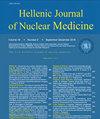多模式放射性核素分流造影检查装置的通畅性:历史上不常见技术的新程序提示。
IF 0.9
4区 医学
Q4 RADIOLOGY, NUCLEAR MEDICINE & MEDICAL IMAGING
引用次数: 0
摘要
脑脊液(CSF)分流术是治疗脑积水的长期疗法,也是西方国家最常用的神经外科手术之一。尽管脑脊液分流术的设计和管理取得了进步,但其失败率仍然很高,最常见的原因是阻塞和感染。使用锝-99m-二乙烯三胺醋酸(99mTc-DTPA)进行放射性核素分流造影是评估脑脊液分流和处理分流相关问题患者的有效技术,特别是可以避免不必要的置换干预。虽然其操作和解释需要特定的技能,但我们建议将其用于评估装置的通畅性。我们在此介绍利用最新的混合多模态技术进行放射性核素分流造影的方法,该方法是为一名患有肾积水和肿瘤性疾病的复杂患者量身定制的。我们建议将放射性核素分流术与传统成像技术相结合,并强烈建议额外进行单光子发射计算机断层扫描/计算机断层扫描(SPECT/CT),因为它还能为平面图像的完整解读提供有价值的信息。本文章由计算机程序翻译,如有差异,请以英文原文为准。
Multimodal radionuclide shuntography for device patency: New procedural tips for anuncommon historical technique.
Cerebrospinal fluid (CSF) shunting is an established long-term treatment option for hydrocephalus, and is one of the most commonly performed neurosurgical procedures in western countries.Despite advances in CSF shunt design and management, its failure rates remain high and is most commonly due to obstruction and infection.Cerebrospinal fluidshunt failure diagnosis should be prompt and accurate in establishing timely if its revision is appropriate. Radionuclide shuntography with technetium-99m-diethylenetriaminepetaacetic acid (99mTc-DTPA) is a useful technique for evaluation CSF shunts and management of patients presenting with shunt-related problems, in particular it can avoid unnecessary replacement interventions. Although its execution and interpretation require specific skills, we suggest its execution for the evaluation of device's patency. We here describe the radionuclide shuntography performed with recent hybrid multimodal technologies, with a procedure customized to a complicated patient with hydrocefalus and neoplastic disease. We suggest considering radionuclide shuntography in association with conventional imagingand strongly recommend the additional performance of single photon emission computed tomography/computed tomography (SPECT/CT) because it also provides valuable information to complete the interpretation of planar images.
求助全文
通过发布文献求助,成功后即可免费获取论文全文。
去求助
来源期刊
CiteScore
1.40
自引率
6.70%
发文量
34
审稿时长
>12 weeks
期刊介绍:
The Hellenic Journal of Nuclear Medicine published by the Hellenic Society of
Nuclear Medicine in Thessaloniki, aims to contribute to research, to education and
cover the scientific and professional interests of physicians, in the field of nuclear
medicine and in medicine in general. The journal may publish papers of nuclear
medicine and also papers that refer to related subjects as dosimetry, computer science,
targeting of gene expression, radioimmunoassay, radiation protection, biology, cell
trafficking, related historical brief reviews and other related subjects. Original papers
are preferred. The journal may after special agreement publish supplements covering
important subjects, dully reviewed and subscripted separately.

 求助内容:
求助内容: 应助结果提醒方式:
应助结果提醒方式:


